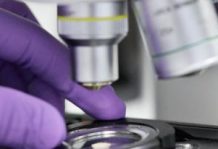Bacterial diversity of the oral cavity
The primary colonisers are mainly gram-positive bacteria – cocci and bacilli – which bind to salivary protein antigens, by specificity of the bacterial membrane adhesins.
It has been shown that four hours after professional cleaning, between 60 and 90% of the dental surface is colonised by bacteria from the Streptococcus genus (S. sanguis, S. mitis and S. oralis). The rest is colonised by bacteria such as Actinomyces naeslundii, Actinomyces israelii, Veillonella parvula, Veillonella atypica, Capnocytophaga spp, Haemophilus spp, Propionibacterium spp, among others. These microorganisms are the pioneers in dental plaque formation. After seven days, the Streptococcus genus dominates plaque (S. mutans, S. salivarius, S. gordonii, S. parasanguis). After these primary colonisers, the secondary colonisers come into play. After two weeks, gram-negative bacteria begin to proliferate, among which Fusobacterium nucleatum is the chief source of connection between primary and tertiary colonisers. The latter are considered, in some cases, to be periodontal disease inducing agents. Among these species, all of which are anaerobes, we find Eikenella corrodens, Porphyromonas gingivalis, Treponema denticola, Tannerella forsythia, Prevotella intermedia, Prevotella loescheii, Capnocytophaga spp and Aggregatibacter actinomycetemcomitans (Donlan et al. 20021; Socransky et al. 20002; Socransky et al. 20032; Xu et al., 20023).
Microbial clusters in subgingival biofilms

Using the checkerboard technique, which consists of DNA-DNA hybridisation (Socransky et al., 1994)4 using specific probes for 40 bacterial species, subgingival plaque was determined to contain bacterial species integrated in different clusters (red, orange, green, yellow, etc.). These seem to have a different association with the different stages of microbial plaque development and with periodontal disease severity. The most virulent species (red cluster) include Porphyromonas gingivalis, Treponema forshytensis and Treponema denticola. Species detected at the initiation of plaque formation and that are also present in the gingival sulcus of healthy patients (yellow and green clusters), several streptococcus species and facultative anaerobic gram-negative bacilli. The presence of the latter species conditions the appearance of species such as Prevotella intermedia and Campylobacter rectus (orange cluster), that are directly Involved in the development of periodontitis. Other species, such as Actinomyces odontolycus and Veillonella parvula have been grouped in a fifth cluster (purple cluster). Some species such as Aggregatibacter actinomycetemcomitans serotype b, Actinomyces naeslundii and Selenomonas noxia, have not been included in any cluster, because they are atypical and show little relation to each other and to the five main clusters (Socransky et al., 19985, Cassio and Elizaur, 20086).

Bacterial interactions and successions during oral biofilm formation
The study of oral microbial communities, such as in vitro biofilms, marks the importance of the structural and physiological interactions between bacterial species in plaque.
An oral bacterial community is not a random and disorganised accumulation of the species it holds. Certain species – primary colonisers in biofilm development – establish the conditions and act as receptors for the colonisation by other organisms. This is why some species are commonly related to a specific group of other species. Many are related to a limited group of “members”, while others, like Fusobacterium nucleatum, adhere to a wide range of species. Initial adhesion to a solid surface and coaggregation play an important role in the organisation between species, together with the involvement of specific adhesins and receptors. Although, communication also exists within and between species (signalling), regulating the genes that control biofilm development.
- Donlan, Costerton JW. Biofilms: Survival Mechanisms of Clinically Relevant Microorganisms. Clinical Microbiology Reviews 2002;167-93.
- Socransky SS, Haffajee AD. Biofilms dentales: objetivos terapeúticos difíciles. Periodontol 2000 2003;3:12-55.
- Xu KD, McFeters GA, Stewart PS. Biofilm resistance to antimicrobial agents. Microbiology 2000: 146: 547-9.
- Socransky, S.S., Smith, C., Martin, L., Paster, B.J., Dewhirst, F.E. and Levin, A.E. (1994) ‘Checkerboard’ DNA–DNA hybridization. Biotechniques 17, 788–792.
- Socransky SS, Haffajee AD, Cugini MA, Smith C and Kent RL. Microbial complexes in subgingival plaque. Journal of Clinical Periodontology 1998; 25: 134–144.
- Cássio do Nascimento JP. y Elizaur AB. Uso de la técnica de hibridización checkerboard ADN-ADN para la identificación de la microbiota periimplantaria. Revisión bibliográfica. Act Odon Ven 2008;(46)3
 initiative
initiative 
